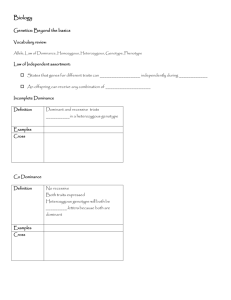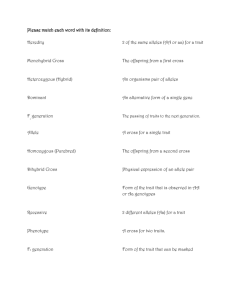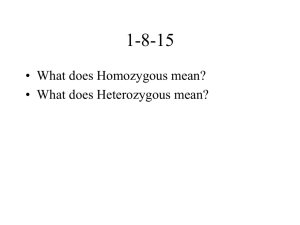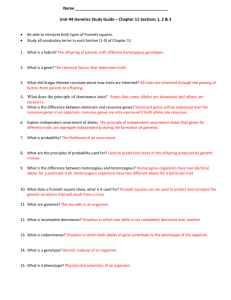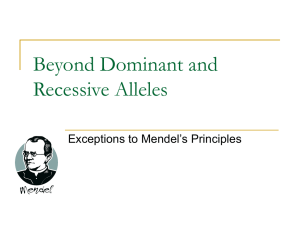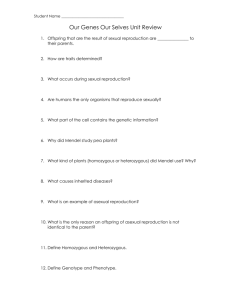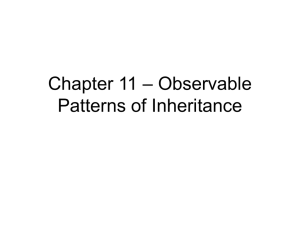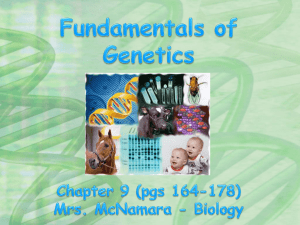Fundamentals of Genetics
advertisement
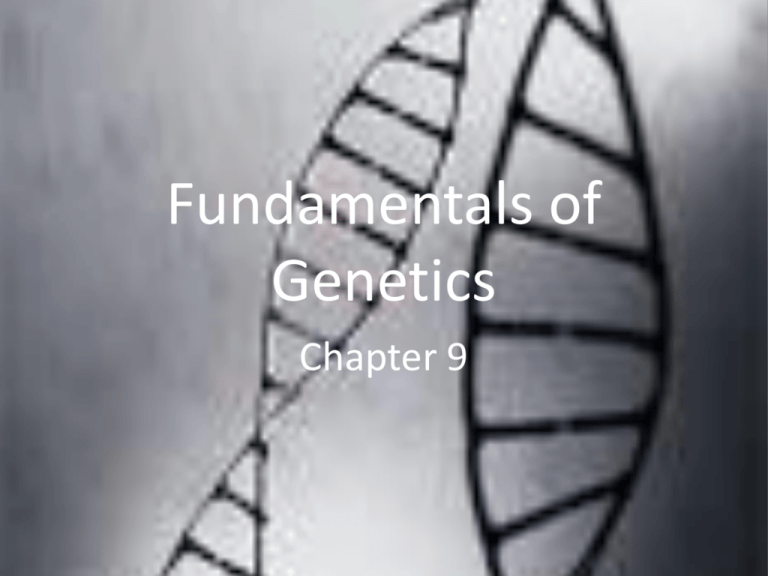
Fundamentals of Genetics Chapter 9 Trait Description Tongue rolling Dimples Widow’s peak Hitchhiker’s Thumb Hand clasping, left over right thumb Arm folding fold your arms across your chest/stomach…which one is on top? Free earlobe Chin cleft Hair on middle joints of fingers Short big toe Ear points Round face Curly hair Blue Eyes Brown Hair Class numbers Genetics is….. • The study of heredity, how characteristics are transmitted from parents to offspring. Gregor Mendel “Father of Genetics” • Mendel studied garden peas and constructed the basis of genetics still used today. • He observed 7 traits in the plants (ex. plant height ) • He noticed that traits in the offspring varied from the parent (ex. short plants came from tall plants). 7 traits- pg 167 (DO NOT COPY) 1. 2. 3. 4. 5. 6. 7. Position of flower along stem Height of plant Pod appearance Pod color Seed texture Seed color Flower color Mendel’s Experiments • Mendel grew pure plants for each of the 7 traits (pure meaning the offspring were just like the parent plants) • He called this the P1 generation • The pure plants were then crosspollinated (tall plant crossed with a short plant) • These plants were the F1 generation • The F1 generation was allowed to selfpollinate • These plants were called the F2 generation Test • P1 generation – Tall plant x short plant • F1 generation – All tall plants (where are the short plants?) • F2 generation – Tall and short plants present Mendel’s Conclusions • There are dominant and recessive traits. A dominant trait masks a recessive trait. • During the formation of sex cells, alleles are separated (one allele for a trait per sex cell)- Law of segregation • Alleles for different characteristics are distributed to sex cells independently – Law of independent assortment. Genes • A gene is a segment of DNA on a chromosome that controls a particular trait (ex. height of a plant, eye color) • Genes occur in pairs, alleles make up the pair • Letters are used to represent alleles. Capital letter represents a dominant allele and a lower case represents a recessive allele. • T= tall plant; t = short plant • When both alleles of a pair are alike it is said to be homozygous (TT or tt) • When the alleles of a pair are different it is said to be heterozygous (Tt) Genotype vs. Phenotype • Genotype – genetic makeup of an individual ; ex. Bb or TT • Phenotype – physical expression of the genotype; ex. brown eyes or tall plant Punnett Square A punnett square….. • A diagram used by biologists to aid them in predicting the probability that certain traits will be inherited by offspring • Types of crosses – Monohybrid – cross b/t one pair of traits Ex. Tt x TT – Dihybrid – cross b/t two pair of traits Ex. TtGG x TTgg 3 possibilities…. • Homozygous x Homozygous • Homozygous x Heterozygous • Heterozygous x Heterozygous Do you know the genotype of a guinea pig just by looking at its appearance? • Black is the dominant coat color • BB or Bb would produce a black coat • To tell which, do a test cross and compare to offspring of the pig • Cross with a homozygous recessive Incomplete Dominance • Two or more alleles influence the phenotype and cause a blending of traits. • Flower color, mouse coat, sickle cell anemia Codominance (co= exist together) • Two or more alleles influence the phenotype and cause both phenotypes to appear. • Cattle coat color (spots) or Blood types (AB) • Do the Punnett square using different letters because neither traits are dominant The “real” story behind eye color...... There are many genes involved and eye color can range from brown to hazel to green to blue to... How does eye color work? Eye color comes from a combination of black and yellow pigments called melanin in the iris of your eye. If you have no melanin in the front part of your iris, you have blue eyes. An increasing proportion of the yellow melanin, in combination with the black melanin, results in shades of colors between brown and blue, including green and hazel. What we are taught in high school biology is generally true, brown eye genes are dominant over green eye genes which are both dominant over blue eye genes. However, because many genes are required and certain combinations of pigments , there many possibilities in shades and color of ones eyes.
